DS:八大排序之归并排序、计数排序
一、归并排序
1.1 思想
归并排序(MERGE-SORT)是建立在归并操作上的一种有效的排序算法,该算法是采用分治法(Divide andConquer)的一个非常典型的应用。将已有序的子序列合并,得到完全有序的序列;即先使每个子序列有序,再使子序列段间有序。若将两个有序表合并成一个有序表,称为二路归并。

还有一个关键点就是:归并一定要先拷贝到一个新数组里面,再拷贝到原数组!!
1.2 递归实现归并排序
根据上面的思路,我们来实现代码:
void _MergeSort(int* a, int begin, int end, int* temp)
{
if (begin == end)
return;//设置递归返回条件
int mid = (begin + end) / 2;
//开始分解
_MergeSort(a, begin, mid, temp);//左区间归并
_MergeSort(a, mid+1, end, temp);//右区间归并
//开始进行总归并
int begin1 = begin, end1 = mid;//设置指针指向左区间
int begin2 = mid + 1, end2 = end;//设置指针指向右区间
int i = begin;//用来遍历拷贝数组
while (begin1 <= end1 && begin2 <= end2)//只要有一个先拷贝完,就跳出循环
{
//谁小谁尾插
if (a[begin1] < a[begin2])
temp[i++] = a[begin1++];
else
temp[i++] = a[begin2++];
}
//这个时候其中一个区间先遍历完了,这个时候另一个没有遍历的区间插入就可以了
//以下两个while只会执行一个
while (begin1 <= end1)
temp[i++] = a[begin1++];
while (begin2<=end2)
temp[i++] = a[begin2++];
//归并完成,将temp的数据拷贝回去
memcpy(a + begin, temp + begin, sizeof(int) * (end - begin + 1));//因为递归,拷贝的不一定就是从头开始的,左闭右闭个数要+1;
}
void MergeSort(int* a, int n)
{
int* temp = (int*)malloc(sizeof(int) * n);
if (temp == NULL)
{
perror("malloc fail");
exit(1);
}
//开辟成功,开始进行递归
_MergeSort(a, 0, n - 1, temp);
}要注意:递归的返回条件是begin==end!!因此归并排序每次拆分都是从中间拆分的,所以不可能会出现区间不存在的情况!! 只有可能是区间只有一个元素的情况
1.3 非递归实现归并排序
怎么去思考非递归实现归并排序呢??我们来画图理解:
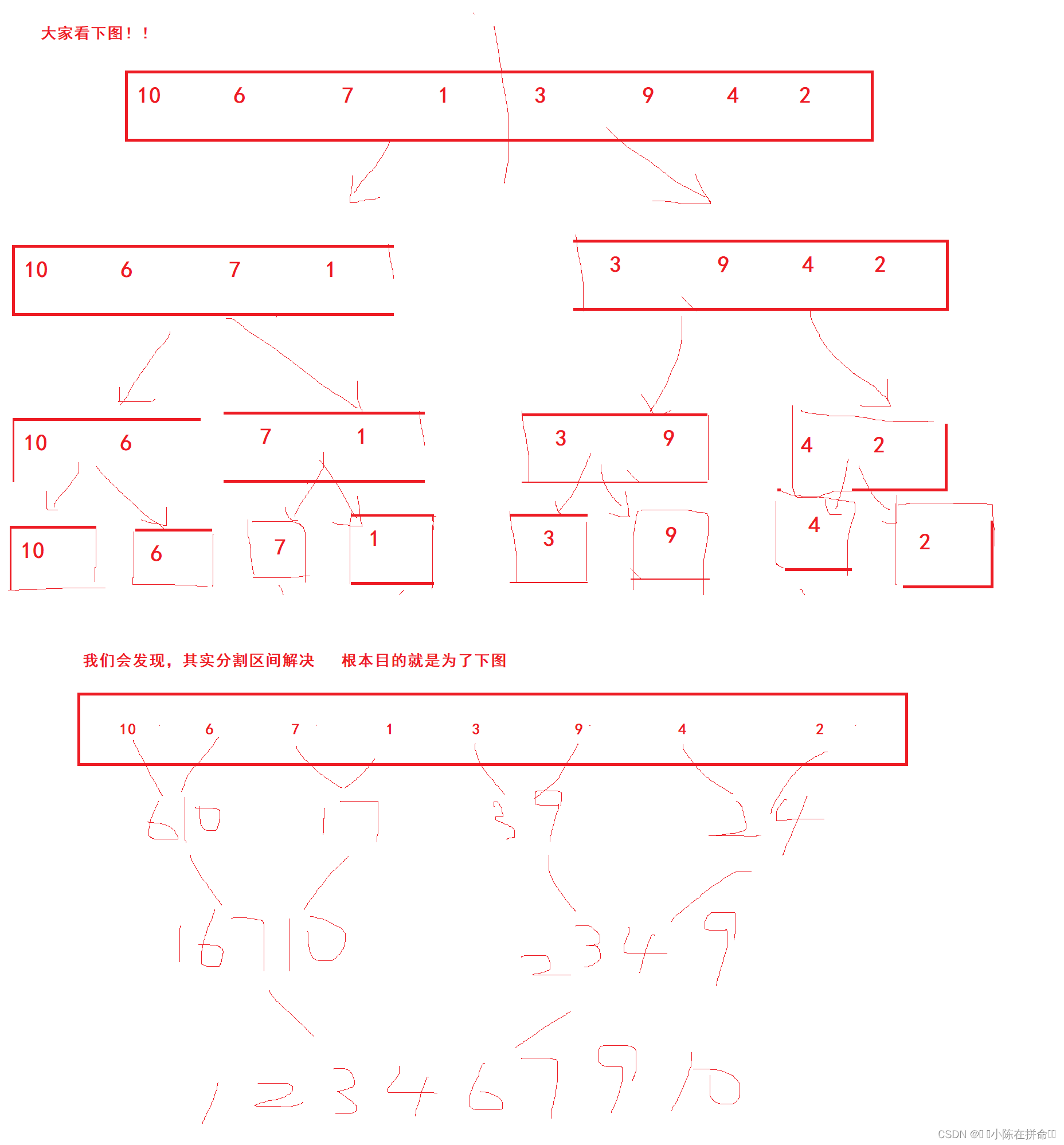
那我们其实可以通过指针来实现各个子区间的有序,直接在原数组上建立两个指针
我们设置一个gap来分割区间
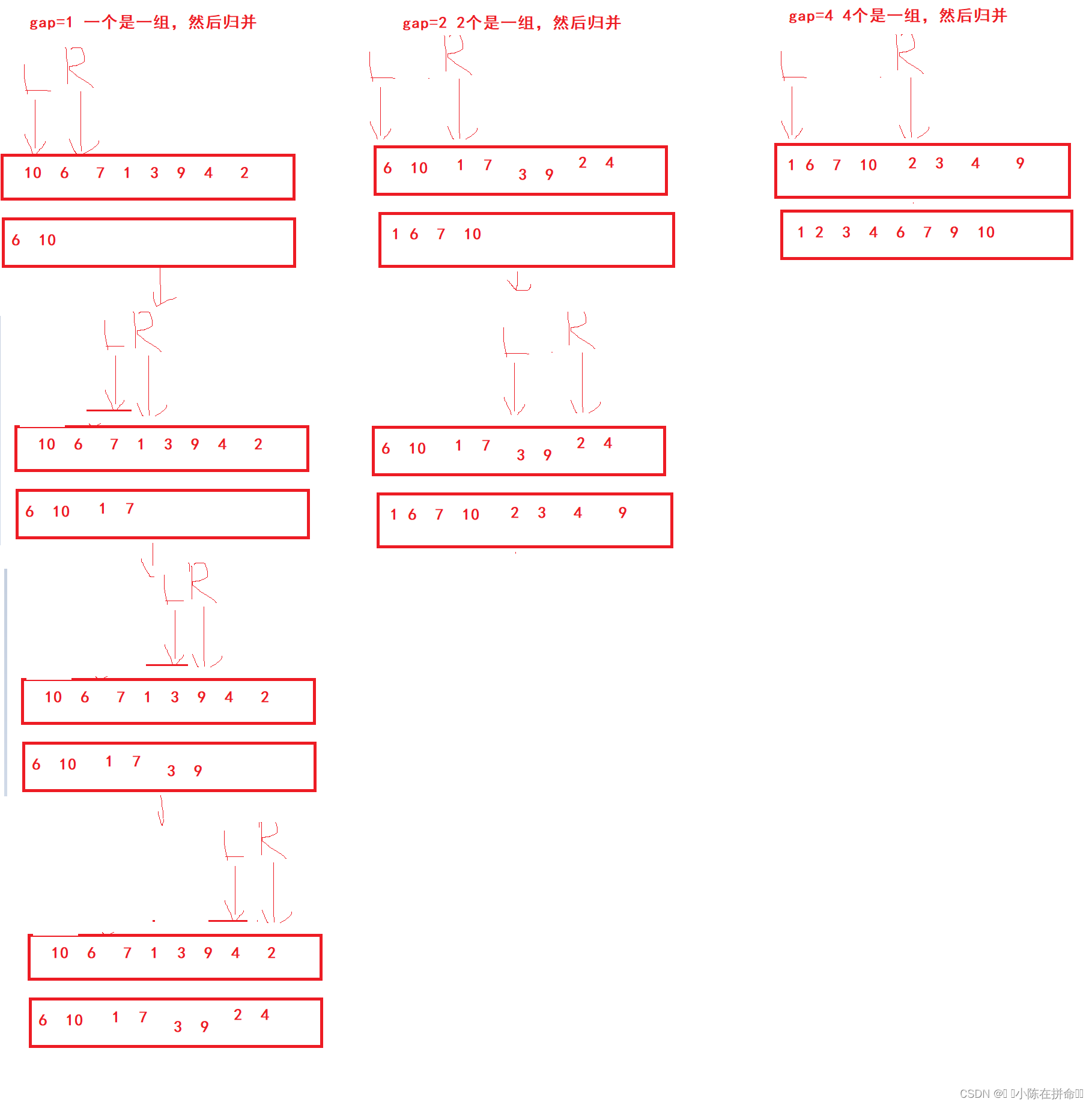
这里的问题就是,如何控制每次归并的子序列的范围?以及什么时候结束归并? 一、gap 控制几个为一组归并(gap一开始从1开始),则: 第一个子序列的起始是begin1 = i, end1 = i + gap -1; 第二个子序列的起始是begin2 = i+gap, end2 = i + 2 *gap - 1; 其中i是遍历一遍待排序的数组的下标,i从0开始。i每次应该跳2*gap步。 二、gap控制的是每次几个为一组我们 一开始是1个,2个、4个、8个,显然是2的倍数,所以gap每次乘等2即可!也不能一直让gap*=2下去,gap不可能大于等于数组的长度,所以当超过数组的长度是结束!
代码实现:
void MergeSortNonR(int* a, int n)
{
int* temp = (int*)malloc(sizeof(int) * n);
if (temp == NULL)
{
perror("malloc fail");
exit(1);
}
//开辟成功
int gap = 1;
while (gap < n)
{
int j = 0;//用来遍历拷贝数组
for (int i = 0; i < n; i += 2 * gap)
{
int begin1 = i, end1 = i + gap - 1;
int begin2 = i + gap, end2 = i + 2 * gap - 1;
while (begin1 <= end1 && begin2 <= end2)//只要有一个先拷贝完,就跳出循环
{
//谁小谁尾插
if (a[begin1] < a[begin2])
temp[j++] = a[begin1++];
else
temp[j++] = a[begin2++];
}
//这个时候其中一个区间先遍历完了,这个时候另一个没有遍历的区间插入就可以了
//以下两个while只会执行一个
while (begin1 <= end1)
temp[j++] = a[begin1++];
while (begin2 <= end2)
temp[j++] = a[begin2++];
//归并完成,将temp的数据拷贝回去
}
memcpy(a, temp, sizeof(int) * n);//一起拷贝回去
gap *= 2;//设置条件
}
}这样对吗?测试一下
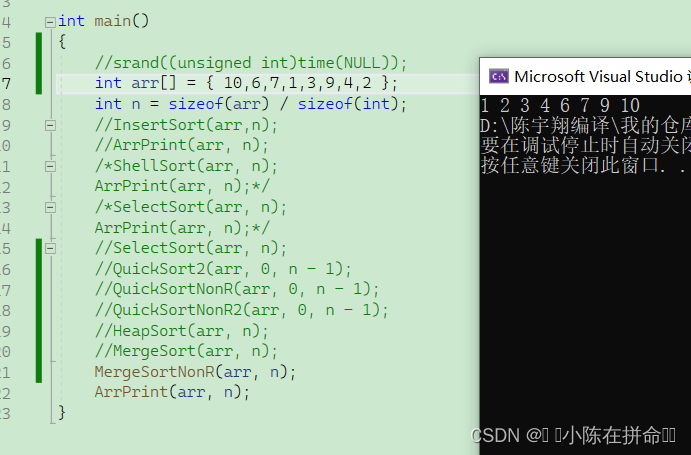
如果我们将数加到10个呢??

越界了!!因为我们之前那个情况是8个元素恰好是2的次方,所以无论怎么分割再归并,都不会越界,所以这个时候我们要考虑边界情况!!

修正版本1:
void MergeSortNonR(int* a, int n)
{
int* temp = (int*)malloc(sizeof(int) * n);
if (temp == NULL)
{
perror("malloc fail");
exit(1);
}
//开辟成功
int gap = 1;
while (gap < n)
{
int j = 0;//用来遍历拷贝数组
for (int i = 0; i < n; i += 2 * gap)
{
int begin1 = i, end1 = i + gap - 1;
int begin2 = i + gap, end2 = i + 2 * gap - 1;
if (end1 >= n || begin2 >= n)
break;
if (end2 >= n)//修正
end2 = n - 1;
while (begin1 <= end1 && begin2 <= end2)//只要有一个先拷贝完,就跳出循环
{
//谁小谁尾插
if (a[begin1] <= a[begin2])
temp[j++] = a[begin1++];
else
temp[j++] = a[begin2++];
}
//这个时候其中一个区间先遍历完了,这个时候另一个没有遍历的区间插入就可以了
//以下两个while只会执行一个
while (begin1 <= end1)
temp[j++] = a[begin1++];
while (begin2 <= end2)
temp[j++] = a[begin2++];
//归并一次,拷贝一次
memcpy(a + i, temp + i, sizeof(int) * (end2-i+1));//一起拷贝回去
}
gap *= 2;//设置条件
}
}修改版本2:
void MergeSortNonR2(int* a, int n)
{
int* temp = (int*)malloc(sizeof(int) * n);
if (temp == NULL)
{
perror("malloc fail");
exit(1);
}
//开辟成功
int gap = 1;
while (gap < n)
{
int j = 0;//用来遍历拷贝数组
for (int i = 0; i < n; i += 2 * gap)
{
int begin1 = i, end1 = i + gap - 1;
int begin2 = i + gap, end2 = i + 2 * gap - 1;
if (end1 >= n)
{
end1 = n - 1;//修正end1
//然后为了让begin2和end2不走循环,直接让他们区间不存在
begin2 = n;
end2 = n - 1;
}
else if (begin2 >= n)
{
//不存在区间
begin2 = n;
end2 = n - 1;
}
else if (end2 >= n)
{ //修正end2
end2 = n - 1;
}
while (begin1 <= end1 && begin2 <= end2)//只要有一个先拷贝完,就跳出循环
{
//谁小谁尾插
if (a[begin1] <= a[begin2])
temp[j++] = a[begin1++];
else
temp[j++] = a[begin2++];
}
//这个时候其中一个区间先遍历完了,这个时候另一个没有遍历的区间插入就可以了
//以下两个while只会执行一个
while (begin1 <= end1)
temp[j++] = a[begin1++];
while (begin2 <= end2)
temp[j++] = a[begin2++];
}
gap *= 2;//设置条件
memcpy(a, temp, sizeof(int) * n);
}
}1.4 归并排序的优化
假设我们的数据非常大,比如100万个数据,一开始的拆分效率是很高的,但是当数据变得很少的时候比如8个,这个时候再继续拆,效率其实很低的
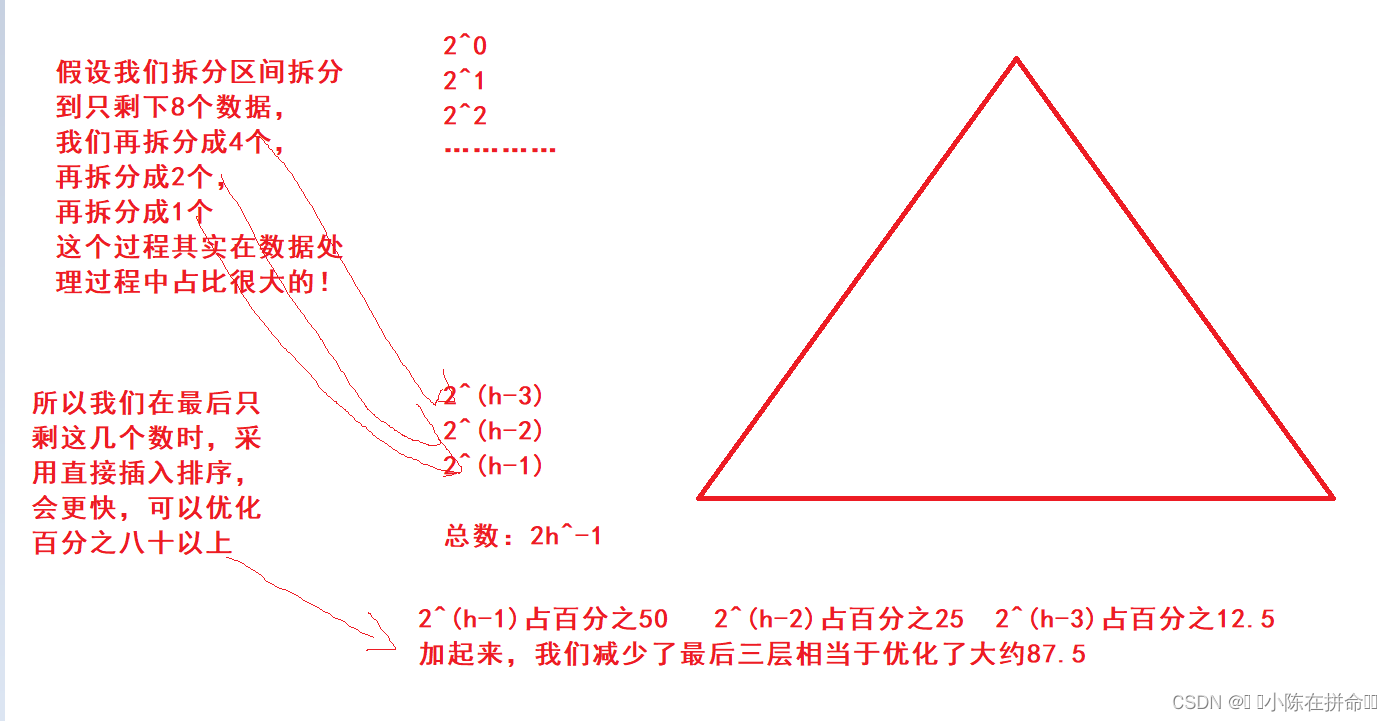
我们当递归只剩大概10个元素的时候,停止递归,使用直接插入排序
void _MergeSort(int* a, int begin, int end, int* temp)
{
if (begin == end)
return;//设置递归返回条件
if (end - begin + 1 < 10)
{
InsertSort(a+begin, end - begin + 1);//优化
return;
}
int mid = (begin + end) / 2;
//开始分解
_MergeSort(a, begin, mid, temp);//左区间归并
_MergeSort(a, mid+1, end, temp);//右区间归并
//开始进行总归并
int begin1 = begin, end1 = mid;//设置指针指向左区间
int begin2 = mid + 1, end2 = end;//设置指针指向右区间
int i = begin;//用来遍历拷贝数组
while (begin1 <= end1 && begin2 <= end2)//只要有一个先拷贝完,就跳出循环
{
//谁小谁尾插
if (a[begin1] < a[begin2])
temp[i++] = a[begin1++];
else
temp[i++] = a[begin2++];
}
//这个时候其中一个区间先遍历完了,这个时候另一个没有遍历的区间插入就可以了
//以下两个while只会执行一个
while (begin1 <= end1)
temp[i++] = a[begin1++];
while (begin2<=end2)
temp[i++] = a[begin2++];
//归并完成,将temp的数据拷贝回去
memcpy(a + begin, temp + begin, sizeof(int) * (end - begin + 1));//因为递归,拷贝的不一定就是从头开始的,左闭右闭个数要+1;
}
void MergeSort(int* a, int n)
{
int* temp = (int*)malloc(sizeof(int) * n);
if (temp == NULL)
{
perror("malloc fail");
exit(1);
}
//开辟成功,开始进行递归
_MergeSort(a, 0, n - 1, temp);
}1.5 复杂度分析
时间复杂度:O(N*logN) 他像二叉树的后序遍历,高度是logN,每一层合计归并时O(N)遍历一遍数组 空间复杂度:O(N) N为辅助数组的长度,和原数组的长度一样!
二、计数排序
2.1 思想
思想:计数排序又称为鸽巢原理,是对哈希直接定址法的变形应用,是一种非比较排序!
步骤:
1、统计相同元素的出现次数
2、根据统计的结果将序列回收到原来的序列中
2.2 计数排序的实现
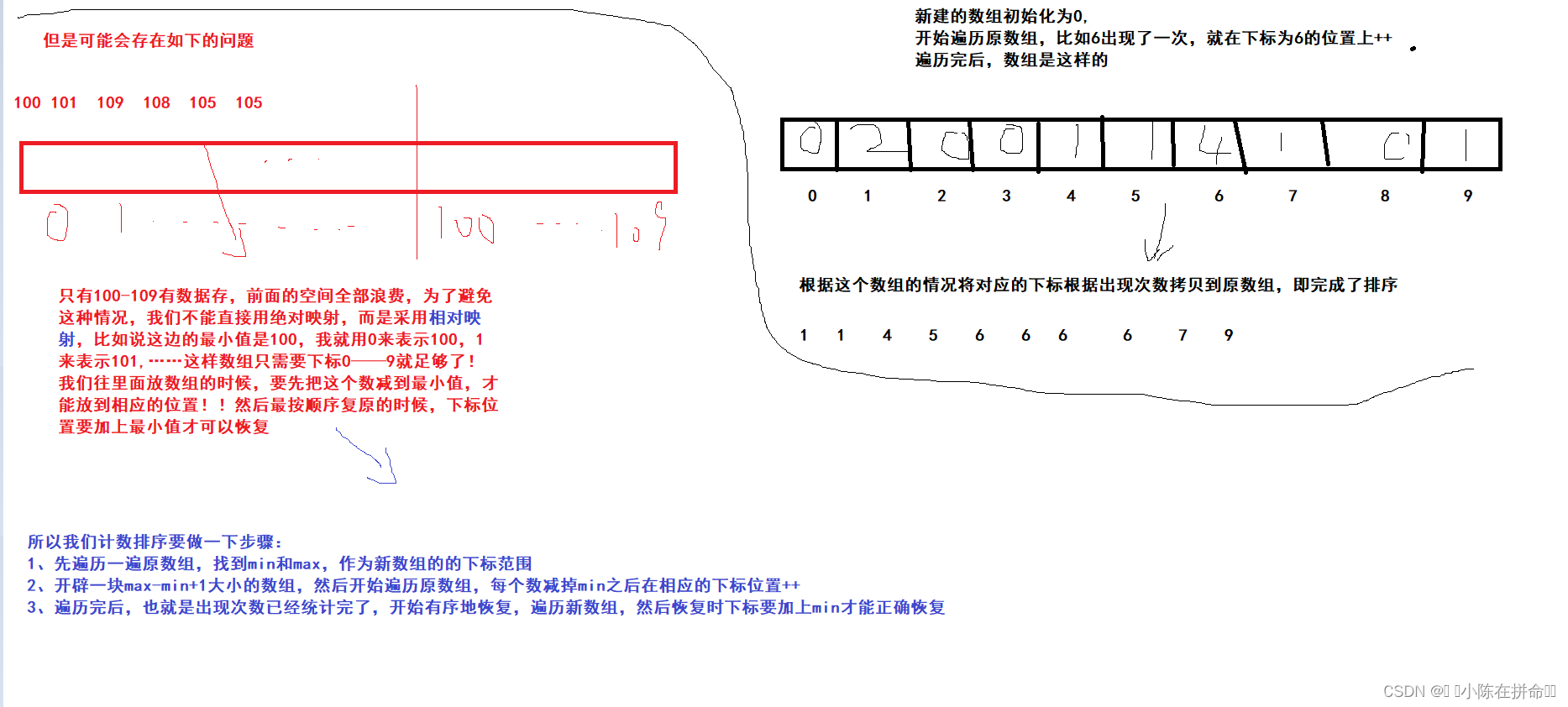
代码实现:
void CountSort(int* a, int n)
{
int min = a[0], max = a[0];//根据最值来确定范围
//遍历原数组找范围
for (int i = 0; i < n; i++)
{
if (a[i] < min)
min = a[i];
if (a[i] > max)
max = a[i];
}
//确定新数组的构建范围
int range = max - min + 1;
int* temp = (int*)calloc(range, sizeof(int));//因为要初始化0,所以用calloc
//也可以先用malloc,然后用memset(temp,0,sizeof(int)*range)
if (temp == NULL)
{
perror("calloc fail");
exit(1);
}
//开辟成功后,开始遍历原数组计数
for (int i = 0; i < n; i++)
temp[a[i] - min]++;
//遍历完后,计数也完成了,开始遍历计数数组,恢复原数组
int k = 0;//用来恢复原数组
for (int j = 0; j < range; j++)
while (temp[j]--)//一直减到0,就会跳下一层循环,直到遍历完!!
a[k++] = j + min;
}2.3 复杂度分析
时间复杂度:O(MAX(N,范围)) 空间复杂度:O(范围)
2.4 计数排序的缺陷
1,只适合范围相对集中的数据
2、只适用与整型,因为只有整型才能和下标建立联系
三、内排序和外排序
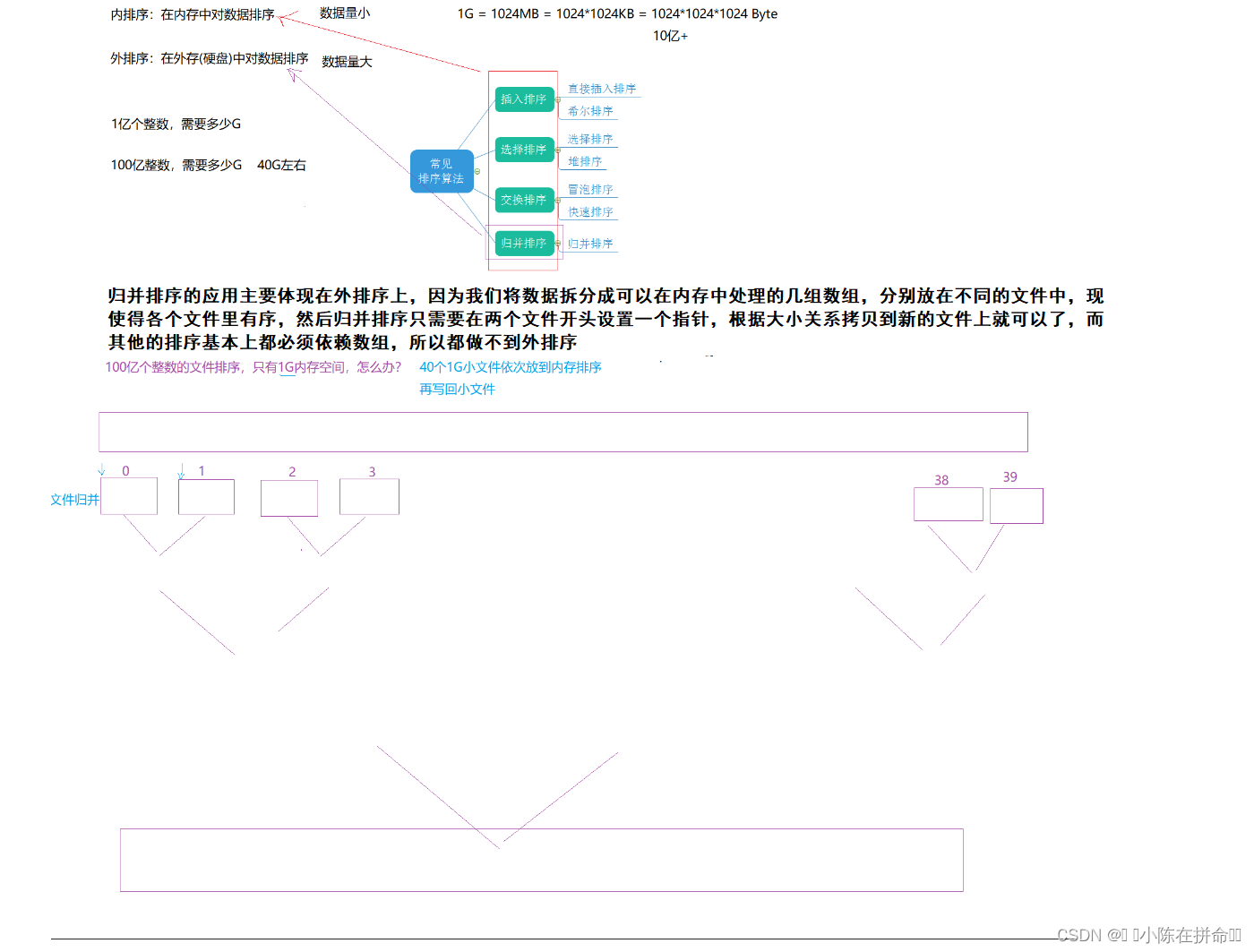
四、稳定性

五、八大排序对比
4.1 代码实现测速度
void TestOP()//测试速度
{
srand((unsigned int)time(NULL));
const int N = 10000;
int* a1 = (int*)malloc(sizeof(int) * N);
int* a2 = (int*)malloc(sizeof(int) * N);
int* a3 = (int*)malloc(sizeof(int) * N);
int* a4 = (int*)malloc(sizeof(int) * N);
int* a5 = (int*)malloc(sizeof(int) * N);
int* a6 = (int*)malloc(sizeof(int) * N);
int* a7 = (int*)malloc(sizeof(int) * N);
int* a8 = (int*)malloc(sizeof(int) * N);
for (int i = 0; i < N; ++i)
{
a1[i] = rand();
a2[i] = a1[i];
a3[i] = a1[i];
a4[i] = a1[i];
a5[i] = a1[i];
a6[i] = a1[i];
a7[i] = a1[i];
a8[i] = a1[i];
}
//clock计入程序走到当前位置的时间
int begin1 = clock();
InsertSort(a1, N);
int end1 = clock();
int begin2 = clock();
ShellSort(a2, N);
int end2 = clock();
int begin3 = clock();
SelectSort(a3, N);
int end3 = clock();
int begin4 = clock();
BubbleSort(a4, N);
int end4 = clock();
int begin5 = clock();
HeapSort(a5, N);
int end5 = clock();
int begin6 = clock();
QuickSort(a6, 0, N - 1);
int end6 = clock();
int begin7 = clock();
MergeSort(a7, N);
int end7 = clock();
int begin8 = clock();
CountSort(a8, N);
int end8 = clock();
printf("InsertSort:%d\n", end1 - begin1);
printf("ShellSort:%d\n", end2 - begin2);
printf("SelectSort:%d\n", end3 - begin3);
printf("BubbleSort:%d\n", end4 - begin4);
printf("HeapSort:%d\n", end5 - begin5);
printf("QuickSort:%d\n", end6 - begin6);
printf("MergeSort:%d\n", end7 - begin7);
printf("CountSort:%d\n", end8 - begin8);
free(a1);
free(a2);
free(a3);
free(a4);
free(a5);
free(a6);
free(a7);
free(a8);
}
int main()
{
TestOP();
}测试一下:
N=10000
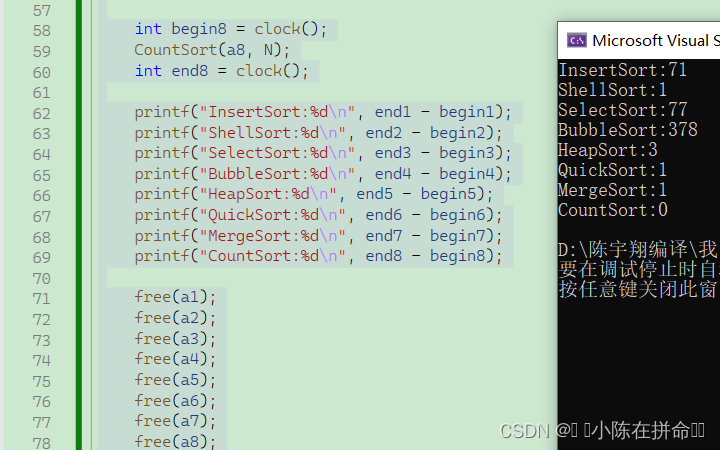
N=100000
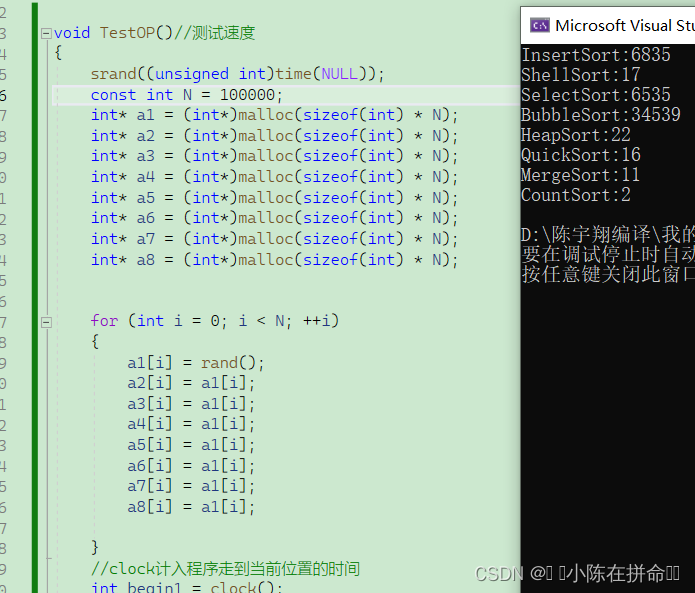
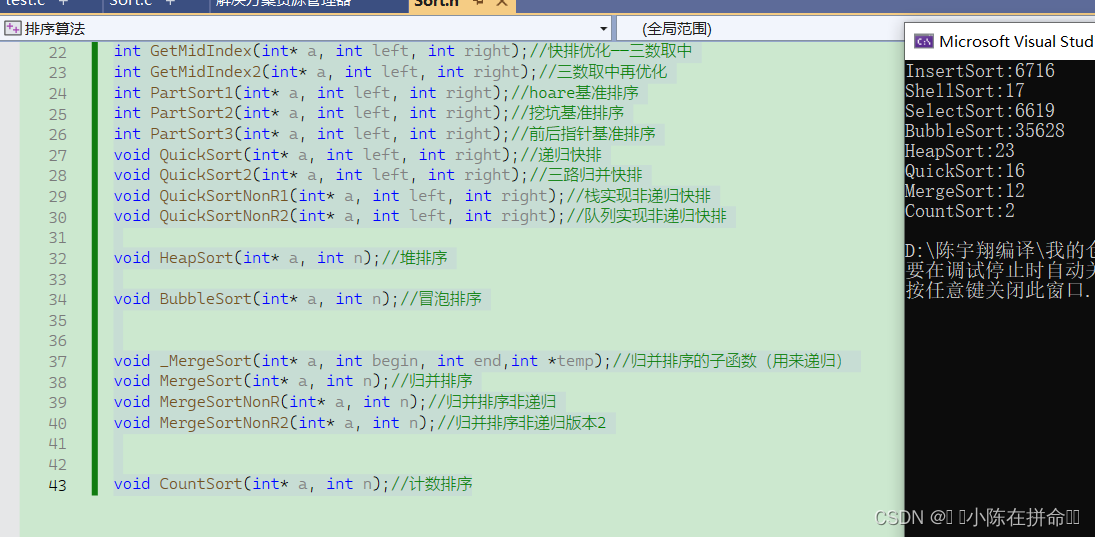
我们发现:
希尔排序、堆排序、快排、归并排、计数牌是一个量级的
N=10000000
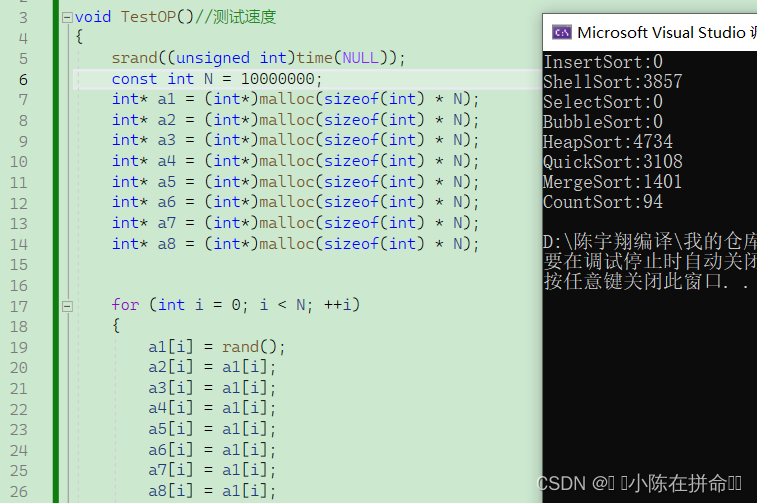
直接插入排、选择排序、冒泡排序是一个量级的
4.2 复杂度稳定性比较
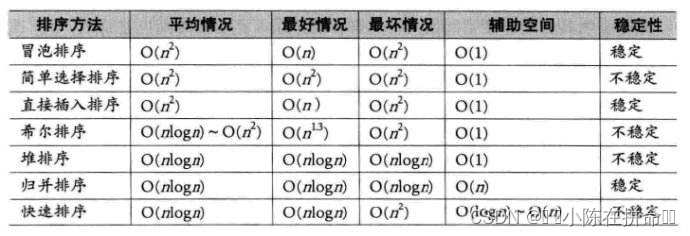
六、八大排序全部代码
建议大家把博主的有关八大排序的代码都看一下
主要是前三个文件,后面四个文件是为了快排的栈实现和队列实现准备的!!
6.1 sort.h
#pragma once
#include<stdio.h>
#include<stdlib.h>
#include<string.h>
#include<time.h>
void ArrPrint(int* a, int n);//用来打印结果
void Swap(int* p1, int* p2);//进行交换
void InsertSort(int* a, int n);//直接插入排序
void ShellSort(int* a, int n);//希尔排序
void SelectSort(int* a, int n);//选择排序
void AdjustDown(int* a, int n, int parent);//向下调整算法
void HeapSort(int* a, int n);//堆排序
void BubbleSort(int* a, int n);//冒泡排序
int GetMidIndex(int* a, int left, int right);//快排优化——三数取中
int GetMidIndex2(int* a, int left, int right);//三数取中再优化
int PartSort1(int* a, int left, int right);//hoare基准排序
int PartSort2(int* a, int left, int right);//挖坑基准排序
int PartSort3(int* a, int left, int right);//前后指针基准排序
void QuickSort(int* a, int left, int right);//递归快排
void QuickSort2(int* a, int left, int right);//三路归并快排
void QuickSortNonR1(int* a, int left, int right);//栈实现非递归快排
void QuickSortNonR2(int* a, int left, int right);//队列实现非递归快排
void HeapSort(int* a, int n);//堆排序
void BubbleSort(int* a, int n);//冒泡排序
void _MergeSort(int* a, int begin, int end,int *temp);//归并排序的子函数(用来递归)
void MergeSort(int* a, int n);//归并排序
void MergeSortNonR(int* a, int n);//归并排序非递归
void MergeSortNonR2(int* a, int n);//归并排序非递归版本2
void CountSort(int* a, int n);//计数排序6.2 sort.c
#include"Sort.h"
#include"Stack.h"
#include"Queue.h"
void ArrPrint(int* a, int n)
{
for (int i = 0; i < n; i++)
printf("%d ", a[i]);
}
void Swap(int* p1, int* p2)
{
int temp = *p1;
*p1 = *p2;
*p2 = temp;
}
void InsertSort(int* a, int n)
{
for (int i = 0; i < n - 1; i++)
{
int end = i;
int temp = a[i+1];
while (end >= 0)
{
if (a[end] > temp)//如果前面的数比后面的数大,就前面元素插入到后面的位置
a[end + 1] = a[end];
else
break;
--end;
}
a[end + 1] = temp;//不写在循环里面,是避免end减成-1,此时说明新加入的牌是最小的,正好放在一开始的位置
}
}
void ShellSort(int* a, int n)
{
//gap>1 预排序
//gap=1 直接插入排序
int gap = n;
while (gap > 1)
{
gap = gap / 3 + 1;//这是为了保证gap最后一定为1
for (int i = 0; i < n - gap; i++)
{
int end = i;
int temp = a[i + gap];
while (end >= 0)
{
if (a[end] > temp)//如果前面的数比后面的数大,就前面元素插入到后面的位置
a[end + gap] = a[end];
else
break;
end -= gap;
}
a[end + gap] = temp;
}
}
}
//
void SelectSort(int* a, int n)
{
int left = 0;
int right = n - 1;
while (left < right)
{
int min = left;
int max = left;
for (int i = left+1; i <= right; i++)
{
if (a[min] > a[i])
min = i;
if (a[max] < a[i])
max = i;
}
//这里要考虑一种情况,就是如果最大的数恰好就在最左端,那么就会导致第二次swap换到后面的就不是最大的数而是最小的数了
Swap(&a[min], &a[left]);
//如果max和begin重叠,修正一下
if (max == left)
max = min;
Swap(&a[max], &a[right]);
left++;
right--;
}
}
int GetMidIndex(int* a, int left, int right)
{
int mid = (left + right) / 2;
if (a[left] < a[mid])
{
if (a[mid] < a[right])
return mid;
else if (a[right] < a[left])
return left;
else
return right;
}
else//a[left] >a[mid]
{
if (a[mid] > a[right])
return mid;
else if (a[right] > a[left])
return left;
else
return right;
}
}
int GetMidIndex2(int* a, int left, int right)
{
int mid = left + (rand() % (right - left));
if (a[left] < a[mid])
{
if (a[mid] < a[right])
return mid;
else if (a[right] < a[left])
return left;
else
return right;
}
else//a[left] >a[mid]
{
if (a[mid] > a[right])
return mid;
else if (a[right] > a[left])
return left;
else
return right;
}
}
int PartSort1(int* a, int left, int right)//hoare基准排序
{
int mid=GetMidIndex(a, left, right);
Swap(&a[mid], &a[left]);
int keyi = left;
while (left < right)
{
//右先找比key大的
while (left < right&&a[right] >= a[keyi])
right--;
//左找比key小的
while (left < right && a[left] <= a[keyi])
left++;
//找到后,就交换
Swap(&a[left], &a[right]);
}
//此时相遇了,把相遇的位置和keyi的位置交换
Swap(&a[left], &a[keyi]);
return left;
}
int PartSort2(int* a, int left, int right)//挖坑基准排序
{
int mid = GetMidIndex(a, left, right);
Swap(&a[mid], &a[left]);
int key = a[left];//记住key的值
int hole = left;//开始挖坑
while (left < right)
{
//右先找比key大的
while (left < right && a[right] >= key)
right--;
//找到后,填坑,然后挖新坑
a[hole] = a[right];
hole = right;
//左找比key小的
while (left < right && a[left] <= key)
left++;
//找到后,填坑,然后挖新坑
a[hole] = a[left];
hole = left;
}
//此时相遇了,把key值放在坑里
a[hole] = key;
return hole;
}
int PartSort3(int* a, int left, int right) //前后指针基准排序
{
int mid = GetMidIndex(a, left, right);
Swap(&a[mid], &a[left]);
int prev = left;
int cur = left + 1;
int keyi = left;
while (cur <= right)//cur走出数组循环停止
{
//cur一直在走,如果遇到比keyi小的,就停下来等perv走一步后交换,再接着走
if (a[cur] < a[keyi]&&++prev!=cur)
Swap(&a[prev], &a[cur]);
cur++;
}
//cur出去后,prev的值和keyi交换
Swap(&a[keyi], &a[prev]);
return prev;
}
void QuickSort(int* a, int left, int right)
{
if (left >= right)
return;
int keyi = PartSort1(a, left, right);
//根据基准值去分割区间,继续进行基准排序
QuickSort(a, left, keyi - 1);
QuickSort(a, keyi+1,right);
}
void QuickSort2(int* a, int left, int right)
{
if (left >= right)
return;
int mid = GetMidIndex2(a, left, right);
Swap(&a[mid], &a[left]);
int phead = left;
int pcur = left + 1;
int ptail = right;
int key = a[left];
while (pcur <= ptail)
{
if (a[pcur] < key)
{
Swap(&a[pcur], &a[phead]);
pcur++;
phead++;
}
else if (a[pcur] > key)
{
Swap(&a[pcur], &a[ptail]);
ptail--;
}
else//a[pcur] = key
pcur++;
}
QuickSort2(a, left, phead - 1);
QuickSort2(a, ptail+1,right);
}
void QuickSortNonR1(int* a, int left, int right)
{
Stack st;
StackInit(&st);
//把区间压进去,一定要先压右区间!!
StackPush(&st, right);
StackPush(&st, left);
while (!StackEmpty(&st))
{
//将数据弹出来进行进准计算
int left = StackTop(&st);
StackPop(&st);
int right= StackTop(&st);
StackPop(&st);
//进行基准计算
int keyi = PartSort3(a, left, right);
//分割区间(left keyi-1)keyi(keyi+1,right)
//如果对应的区间还能分割,就继续压,要注意要先压后面在压前面
if (keyi + 1 < right)
{
StackPush(&st, right);
StackPush(&st, keyi+1);
}
if (keyi - 1 > left)
{
StackPush(&st, keyi-1);
StackPush(&st,left);
}
}
//会一直到栈为空,此时就拍好序了!!
StackDestory(&st);
}
void QuickSortNonR2(int* a, int left, int right)
{
Queue q;
QueueInit(&q);
QueuePush(&q, left);
QueuePush(&q, right);
while (!QueueEmpty(&q))
{
int left = QueueFront(&q);
QueuePop(&q);
int right = QueueFront(&q);
QueuePop(&q);
int keyi = PartSort3(a, left, right);
if (keyi - 1 > left)
{
QueuePush(&q, left);
QueuePush(&q, keyi-1);
}
if (keyi + 1 <right)
{
QueuePush(&q, keyi +1);
QueuePush(&q, right);
}
}
QueueDestory(&q);
}
//向下调整算法
void AdjustDown(int* a, int n, int parent)//升序要建大堆
{
int child = parent * 2 + 1;//假设左孩子比右孩子大
while (child < n)
{
//如果假设错误,就认错
if (child + 1 < n && a[child] < a[child + 1])
child++;
//如果孩子大于父亲,交换
if (a[child] > a[parent])
{
Swap(&a[child], &a[parent]);
//交换完后,让原来的孩子变成父亲,然后再去找新的孩子
parent = child;
child = parent * 2 + 1;
}
else
break;
}
}
void HeapSort(int* a, int n)
{
//向下调整建堆
for (int i = (n - 1 - 1) / 2; i >= 0; i--)
AdjustDown(a, n, i);
//大堆,向下调整
int end = n - 1;
while (end >= 0)
{
Swap(&a[0], &a[end]);
AdjustDown(a, end, 0);
end--;
}
}
void BubbleSort(int* a, int n)
{
for (int i = 0; i < n - 1; i++)
//每一趟拍好一个,最后排完n-1个,最后一个数就没必要比了
{
int flag = 1;//假设有序
for (int j = 0; j < n - i - 1; j++)//第一趟需要比较的n-1次,第二次需要比较n-2次……
//所以结束条件跟着i变化
{
if (a[j] > a[j + 1])
{
Swap(&a[j], &a[j + 1]);
flag = 0;//如果没有发生交换,说明不符合有序
}
}
if (flag == 1)
break;
}
}
void _MergeSort(int* a, int begin, int end, int* temp)
{
if (begin == end)
return;//设置递归返回条件
if (end - begin + 1 < 10)
{
InsertSort(a+begin, end - begin + 1);//优化
return;
}
int mid = (begin + end) / 2;
//开始分解
_MergeSort(a, begin, mid, temp);//左区间归并
_MergeSort(a, mid+1, end, temp);//右区间归并
//开始进行总归并
int begin1 = begin, end1 = mid;//设置指针指向左区间
int begin2 = mid + 1, end2 = end;//设置指针指向右区间
int i = begin;//用来遍历拷贝数组
while (begin1 <= end1 && begin2 <= end2)//只要有一个先拷贝完,就跳出循环
{
//谁小谁尾插
if (a[begin1] < a[begin2])
temp[i++] = a[begin1++];
else
temp[i++] = a[begin2++];
}
//这个时候其中一个区间先遍历完了,这个时候另一个没有遍历的区间插入就可以了
//以下两个while只会执行一个
while (begin1 <= end1)//等于才能保证稳定性!!
temp[i++] = a[begin1++];
while (begin2<=end2)
temp[i++] = a[begin2++];
//归并完成,将temp的数据拷贝回去
memcpy(a + begin, temp + begin, sizeof(int) * (end - begin + 1));//因为递归,拷贝的不一定就是从头开始的,左闭右闭个数要+1;
}
void MergeSort(int* a, int n)
{
int* temp = (int*)malloc(sizeof(int) * n);
if (temp == NULL)
{
perror("malloc fail");
exit(1);
}
//开辟成功,开始进行递归
_MergeSort(a, 0, n - 1, temp);
}
void MergeSortNonR(int* a, int n)
{
int* temp = (int*)malloc(sizeof(int) * n);
if (temp == NULL)
{
perror("malloc fail");
exit(1);
}
//开辟成功
int gap = 1;
while (gap < n)
{
int j = 0;//用来遍历拷贝数组
for (int i = 0; i < n; i += 2 * gap)
{
int begin1 = i, end1 = i + gap - 1;
int begin2 = i + gap, end2 = i + 2 * gap - 1;
if (end1 >= n || begin2 >= n)
break;
if (end2 >= n)//修正
end2 = n - 1;
while (begin1 <= end1 && begin2 <= end2)//只要有一个先拷贝完,就跳出循环
{
//谁小谁尾插
if (a[begin1] <= a[begin2])
temp[j++] = a[begin1++];
else
temp[j++] = a[begin2++];
}
//这个时候其中一个区间先遍历完了,这个时候另一个没有遍历的区间插入就可以了
//以下两个while只会执行一个
while (begin1 <= end1)
temp[j++] = a[begin1++];
while (begin2 <= end2)
temp[j++] = a[begin2++];
//归并一次,拷贝一次
memcpy(a + i, temp + i, sizeof(int) * (end2-i+1));//一起拷贝回去
}
gap *= 2;//设置条件
}
}
void MergeSortNonR2(int* a, int n)
{
int* temp = (int*)malloc(sizeof(int) * n);
if (temp == NULL)
{
perror("malloc fail");
exit(1);
}
//开辟成功
int gap = 1;
while (gap < n)
{
int j = 0;//用来遍历拷贝数组
for (int i = 0; i < n; i += 2 * gap)
{
int begin1 = i, end1 = i + gap - 1;
int begin2 = i + gap, end2 = i + 2 * gap - 1;
if (end1 >= n)
{
end1 = n - 1;//修正end1
//然后为了让begin2和end2不走循环,直接让他们区间不存在
begin2 = n;
end2 = n - 1;
}
else if (begin2 >= n)
{
//不存在区间
begin2 = n;
end2 = n - 1;
}
else if (end2 >= n)
{ //修正end2
end2 = n - 1;
}
while (begin1 <= end1 && begin2 <= end2)//只要有一个先拷贝完,就跳出循环
{
//谁小谁尾插
if (a[begin1] <= a[begin2])
temp[j++] = a[begin1++];
else
temp[j++] = a[begin2++];
}
//这个时候其中一个区间先遍历完了,这个时候另一个没有遍历的区间插入就可以了
//以下两个while只会执行一个
while (begin1 <= end1)
temp[j++] = a[begin1++];
while (begin2 <= end2)
temp[j++] = a[begin2++];
}
gap *= 2;//设置条件
memcpy(a, temp, sizeof(int) * n);
}
}
void CountSort(int* a, int n)
{
int min = a[0], max = a[0];//根据最值来确定范围
//遍历原数组找范围
for (int i = 0; i < n; i++)
{
if (a[i] < min)
min = a[i];
if (a[i] > max)
max = a[i];
}
//确定新数组的构建范围
int range = max - min + 1;
int* temp = (int*)calloc(range, sizeof(int));//因为要初始化0,所以用calloc
//也可以先用malloc,然后用memset(temp,0,sizeof(int)*range)
if (temp == NULL)
{
perror("calloc fail");
exit(1);
}
//开辟成功后,开始遍历原数组计数
for (int i = 0; i < n; i++)
temp[a[i] - min]++;
//遍历完后,计数也完成了,开始遍历计数数组,恢复原数组
int k = 0;//用来恢复原数组
for (int j = 0; j < range; j++)
while (temp[j]--)//一直减到0,就会跳下一层循环,直到遍历完!!
a[k++] = j + min;
}6.3 test.c
#include"Sort.h"
void TestOP()//测试速度
{
srand((unsigned int)time(NULL));
const int N = 1000000;
int* a1 = (int*)malloc(sizeof(int) * N);
int* a2 = (int*)malloc(sizeof(int) * N);
int* a3 = (int*)malloc(sizeof(int) * N);
int* a4 = (int*)malloc(sizeof(int) * N);
int* a5 = (int*)malloc(sizeof(int) * N);
int* a6 = (int*)malloc(sizeof(int) * N);
int* a7 = (int*)malloc(sizeof(int) * N);
int* a8 = (int*)malloc(sizeof(int) * N);
for (int i = 0; i < N; ++i)
{
a1[i] = rand();
a2[i] = a1[i];
a3[i] = a1[i];
a4[i] = a1[i];
a5[i] = a1[i];
a6[i] = a1[i];
a7[i] = a1[i];
a8[i] = a1[i];
}
//clock计入程序走到当前位置的时间
int begin1 = clock();
//InsertSort(a1, N);
int end1 = clock();
int begin2 = clock();
ShellSort(a2, N);
int end2 = clock();
int begin3 = clock();
//SelectSort(a3, N);
int end3 = clock();
int begin4 = clock();
//BubbleSort(a4, N);
int end4 = clock();
int begin5 = clock();
HeapSort(a5, N);
int end5 = clock();
int begin6 = clock();
QuickSort(a6, 0, N - 1);
int end6 = clock();
int begin7 = clock();
MergeSort(a7, N);
int end7 = clock();
int begin8 = clock();
CountSort(a8, N);
int end8 = clock();
printf("InsertSort:%d\n", end1 - begin1);
printf("ShellSort:%d\n", end2 - begin2);
printf("SelectSort:%d\n", end3 - begin3);
printf("BubbleSort:%d\n", end4 - begin4);
printf("HeapSort:%d\n", end5 - begin5);
printf("QuickSort:%d\n", end6 - begin6);
printf("MergeSort:%d\n", end7 - begin7);
printf("CountSort:%d\n", end8 - begin8);
free(a1);
free(a2);
free(a3);
free(a4);
free(a5);
free(a6);
free(a7);
free(a8);
}
int main()
{
TestOP();
}6.4 stack.h
#pragma once
#include<stdio.h>
#include<stdbool.h>
#include<stdlib.h>
#include<assert.h>
typedef int STDataType;
//支持动态增长的栈
typedef struct Stack
{
STDataType* a;
int top;//栈顶
int capacity;//栈容量
}Stack;
void StackInit(Stack* ps);//初始化栈
void StackPush(Stack* ps, STDataType x);//入栈
void StackPop(Stack* ps);//出栈
STDataType StackTop(Stack* ps);//获取栈顶元素
int StackSize(Stack* ps);//获取栈中有效元素个数
bool StackEmpty(Stack* ps);//检测栈是否为空,为空返回true
void StackDestory(Stack* ps);//销毁栈6.5 stack.c
#include"Stack.h"
void StackInit(Stack* ps)
{
ps->a = NULL;
ps->top = ps->capacity = 0;
}
void StackPush(Stack* ps, STDataType x)
{
assert(ps);
//判断是否需要扩容
if (ps->top == ps->capacity)
{
int newcapacity = ps->capacity == 0 ? 4 : 2 * ps->capacity;
STDataType* temp = (STDataType*)realloc(ps->a,sizeof(STDataType) * newcapacity);
if (temp == NULL)
{
perror("realloc fail");
exit(1);
}
ps->a = temp;
ps->capacity = newcapacity;
}
//压栈
ps->a[ps->top++] = x;
}
void StackPop(Stack* ps)
{
assert(ps);
//如果栈为空,则没有删除的必要
assert(!StackEmpty(ps));
ps->top--;
}
STDataType StackTop(Stack* ps)
{
assert(ps);
//如果栈为空,不可能有栈顶元素
assert(!StackEmpty(ps));
return ps->a[ps->top - 1];
}
int StackSize(Stack* ps)
{
assert(ps);
return ps->top;
}
bool StackEmpty(Stack* ps)
{
assert(ps);
return ps->top == 0;
}
void StackDestory(Stack* ps)
{
free(ps->a);
ps->a = NULL;
ps->top = ps->capacity = 0;
}6.6 queue.h
#pragma once
#include<stdio.h>
#include<stdlib.h>
#include<stdbool.h>
#include<assert.h>
typedef int QDatatype;//方便后面修改存储数据的数据类型
typedef struct QueueNode//队列结点的数据结构
{
QDatatype data;//存储数据
struct QueueNode* next;
}QNode;
typedef struct Queue
{
QNode* phead;//指向队头,用于出队(头删)
QNode* ptail;//指向队尾,用于入队(尾插)
int size;//记录有效元素个数
}Queue;//创建一个队列相关结构体
void QueueInit(Queue* pq);//队列的初始化
void QueuePush(Queue* pq, QDatatype x);//队列的入队(尾插)
void QueuePop(Queue* pq);//队列的出队(头删)
QDatatype QueueFront(Queue* pq);//获取队列头部元素
QDatatype QueueBack(Queue* pq);//获取队列尾部元素
int QueueSize(Queue* pq);//获取队列中有效元素个数
bool QueueEmpty(Queue* pq);//判断队列是否为空
void QueueDestory(Queue* pq);//队列的销毁6.7 queue.c
#include"Queue.h"
void QueueInit(Queue* pq)
{
assert(pq);//判断传的是不是空指针
pq->phead = pq->ptail = NULL;
pq->size = 0;//因为队列不像栈一样,有一个top表示栈顶元素的下标
//所以如果我们想知道这个队列的有效数据个数,就必须遍历队列
//由于其先进先出的特性,我们默认只能访问到头元素和尾元素
//所以必须访问一个头元素,就出队列一次,这样才能实现遍历
//但是这样的代价太大了,为了方便,我们直接用size
}
void QueuePush(Queue* pq, QDatatype x)
{
assert(pq);
//入队必须从队尾入!
QNode* newnode = (QNode*)malloc(sizeof(QNode));//创建一个新节点
if (newnode==NULL)//如果新节点申请失败,退出程序
{
perror("malloc fail");
}
//新节点创建成功,给新节点初始化一下
newnode->data = x;
newnode->next = NULL;
//开始入队
//如果直接尾插的话,由于会用到ptail->next,所以得考虑队列为空的情况
if (pq->ptail== NULL)//如果为空,直接把让新节点成为phead和ptail
{
//按道理来说,如果ptail为空,phead也应该为空
// 但是有可能会因为我们的误操作使得phead不为空,这个时候一般是我们写错的问题
//所以使用assert来判断一下,有问题的话会及时返回错误信息
assert(pq->phead == NULL);
pq->phead = pq->ptail = newnode;
}
else
{
pq->ptail->next = newnode;
pq->ptail = newnode;
}
pq->size++;
}
void QueuePop(Queue* pq)
{
assert(pq);
//如果队列为空,没有删除的必要
assert(!QueueEmpty(pq));
//队列中的出队列相当于链表的头删
//如果直接头删,那么如果队列只有一个有效数据的话,那么我们将phead的空间释放掉,但是没有将ptail给置空
//这样会导致ptail成为一个野指针,所以我们需要考虑只有一个节点多个节点的情况
if (pq->phead->next == NULL)//一个节点的情况,直接将这个节点释放并置空即可
{
free(pq->phead);
pq->phead = pq->ptail = NULL;//置空,防止野指针
}
else//多个节点的情况,直接头删
{
QNode* next = pq->phead->next;//临时指针记住下一个节点
free(pq->phead);
pq->phead = next;//让下一个节点成为新的头
}
pq->size--;
}
QDatatype QueueFront(Queue* pq)
{
assert(pq);
assert(!QueueEmpty(pq));//队列如果为空,则不可能找得到队列头元素
//队列不为空的时候,直接返回phead指向的数据
return pq->phead->data;
}
QDatatype QueueBack(Queue* pq)
{
assert(pq);
assert(!QueueEmpty(pq));//队列如果为空,则不可能找得到队尾元素
//队列不为空的时候,直接返回ptail指向的数据
return pq->ptail->data;
}
int QueueSize(Queue* pq)
{
assert(pq);
return pq->size;
}
bool QueueEmpty(Queue* pq)//链表为空的情况,可以根据容量,也可以根据ptail==NULL&&phead==NULL
{
assert(pq);
return pq->ptail == NULL && pq->phead == NULL;
}
void QueueDestory(Queue* pq)
{
assert(pq);//判断传的是不是空指针
//要逐个节点释放
QNode* pcur = pq->phead;
while (pcur)
{
QNode* next = pcur->next;
free(pcur);
pcur = next;
}
pq->phead = pq->ptail = NULL;
pq->size = 0;
}
